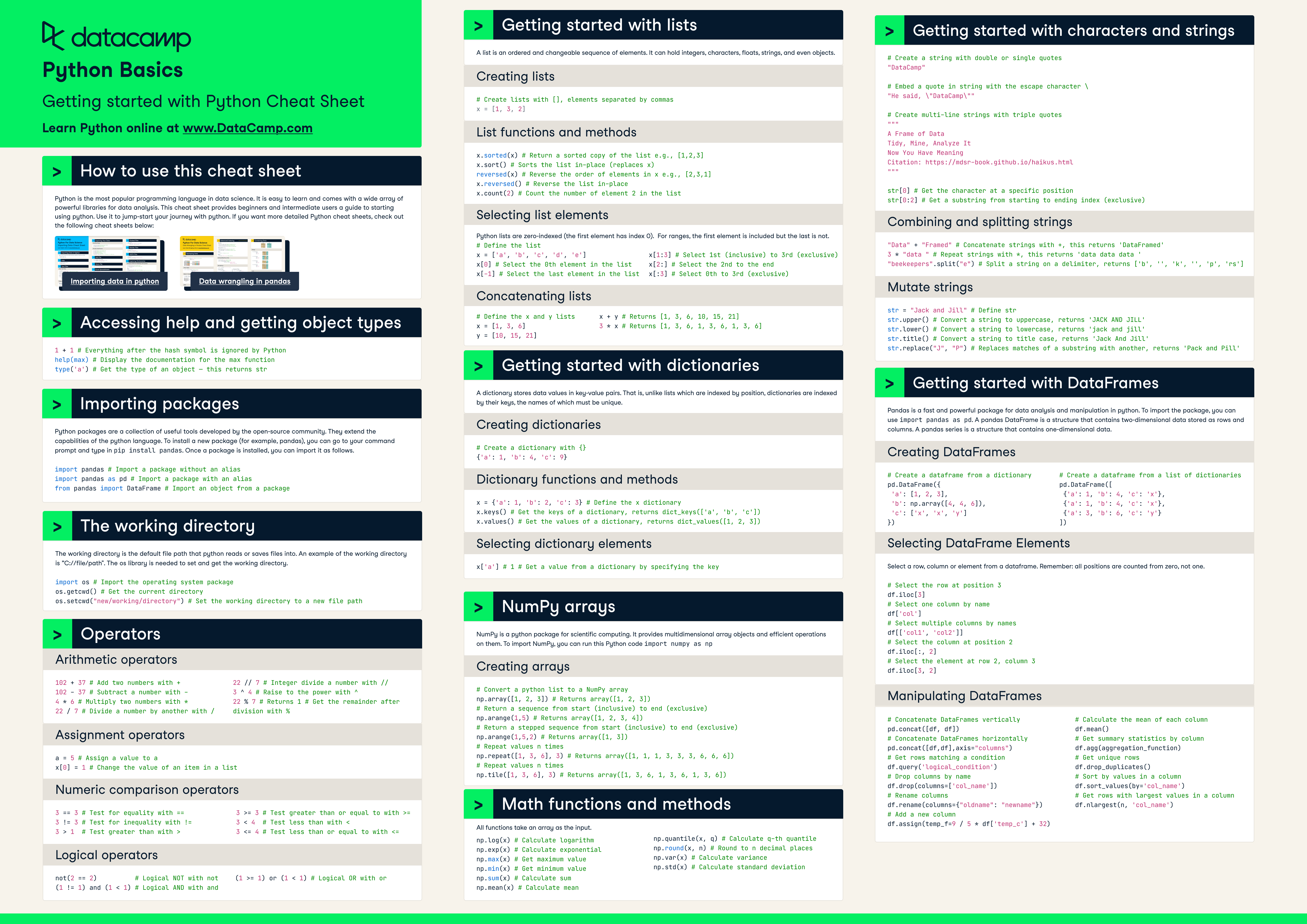Python is the most popular programming language in data science. It is easy to learn and comes with a wide array of powerful libraries for data analysis. This cheat sheet provides beginners and intermediate users a guide to using python. Use it to jump-start your journey with python. Check out other Python cheats sheets if you want more detailed guides.
Have this cheat sheet at your fingertips
Download PDFRun and edit the code from this cheat sheet online
Run codeAccessing help and getting object types
1 + 1 #Everything after the hash symbol is ignored by Python
help(max) #Display the documentation for the max function
type('a') #Get the type of an object — this returns strImporting packages
Python packages are a collection of useful tools developed by the open-source community. They extend the capabilities of the python language. To install a new package (for example, pandas), you can go to your command prompt and type in pip install pandas. Once a package is installed, you can import it as follows.
import pandas # Import a package without an alias
import pandas as pd # Import a package with an alias
from pandas import DataFrame # Import an object from a packageThe working directory
The working directory is the default file path that python reads or saves files into. An example of the working directory is ”C://file/path". The os library is needed to set and get the working directory.
import os # Import the operating system package
os.getcwd() # Get the current directory
os.setcwd("new/working/directory") # Set the working directory to a new file pathOperators
Arithmetic operators
102 + 37 #Add two numbers with +
102 - 37 # Subtract a number with -
4 * 6 # Multiply two numbers with *
22 / 7 # Divide a number by another with /
22 // 7 # Integer divide a number with //
3 ** 4 # Raise to the power with **
22 % 7 # Returns 1 # Get the remainder after division with %Assignment operators
a = 5 # Assign a value to a
x[0] =1 # Change the value of an item in a listNumeric comparison operators
3 == 3 # Test for equality with ==
3 != 3 # Test for inequality with !=
3 > 1 # Test greater than with >
3 >= 3 # Test greater than or equal to with >=
3 < 4 # Test less than with <
3 <= 4 # Test less than or equal to with <=Logical operators
not (2 == 2) # Logical NOT with not
(1 != 1) and (1 < 1) # Logical AND with and
(1 >= 1) or (1 < 1) # Logical OR with orGetting started with lists
A list is an ordered and changeable sequence of elements. It can hold integers, characters, floats, strings, and even objects.
Creating lists
# Create lists with [], elements separated by commas
x = [1, 3, 2]List functions and methods
# Return a sorted copy of the list x
sorted(x) # Returns [1, 2, 3]
# Sort the list in-place (replaces x)
x.sort() # Returns None
# Reverse the order of elements in x
reversed(x) # Returns [2, 3, 1]
# Reverse the list in-place
x.reversed() # Returns None
# Count the number of element 2 in the list
x.count(2)Selecting list elements
Python lists are zero-indexed (the first element has index 0). For ranges, the first element is included, but the last is not.
# Define the list
x = ['a', 'b', 'c', 'd', 'e']
# Select the 0th element in the list
x[0] # 'a'
# Select the last element in the list
x[-1] # 'e'
# Select 1st (inclusive) to 3rd (exclusive)
x[1:3] # ['b', 'c']
# Select the 2nd to the end
x[2:] # ['c', 'd', 'e']
# Select 0th to 3rd (exclusive)
x[:3] # ['a', 'b', 'c']Concatenating lists
# Define the list x and y
x = [1, 3, 6]
y = [10, 15, 21]
# Concatenate lists with +
x + y # [1, 3, 6, 10, 15, 21]
# Repeat list n times with *
3 * x # [1, 3, 6, 1, 3, 6, 1, 3, 6]Getting started with dictionaries
A dictionary stores data values in key-value pairs. That is, unlike lists indexed by position, dictionaries are indexed by their keys, the names of which must be unique.
Creating dictionaries
# Create a dictionary with {}
{'a': 1, 'b': 4, 'c': 9}Dictionary functions and methods
# Define the dictionary
a = {'a': 1, 'b': 2, 'c': 3}
# Get the keys
x.keys() # dict_keys(['a', 'b', 'c'])
# Get the values
x.values() # dict_values([1, 2, 3])
# Get a value from a dictionary by specifying the key
x['a'] # 1NumPy arrays
NumPy is a python package for scientific computing. It provides a multidimensional array of objects and efficient operations on them. To import NumPy, you can run this Python code import numpy as np
Creating arrays
# Convert a python list to a NumPy array
np.array([1, 2, 3]) # array([1, 2, 3])
# Return a sequence from start (inclusive) to end (exclusive)
np.arange(1,5) # array([1, 2, 3, 4])
# Return a stepped sequence from start (inclusive) to end (exclusive)
np.arange(1,5,2) # array([1, 3])
# Repeat values n times
np.repeat([1, 3, 6], 3) # array([1, 1, 1, 3, 3, 3, 6, 6, 6])
# Repeat values n times
np.tile([1, 3, 6], 3) # array([1, 3, 6, 1, 3, 6, 1, 3, 6])Math functions and methods
# Calculate logarithm of an array
np.log(x)
# Calculate exponential of an array
np.exp(x)
# Get maximum value of an array
np.max(x)
# Get minimum value of an array
np.min(x)
# Calculate sum of an array
np.sum(x)
# Calculate mean of an array
np.mean(x)
# Calculate q-th quantile of an array x
np.quantile(x, q)
# Round an array to n decimal places
np.round(x, n)
# Calculate variance of an array
np.var(x)
# Calculate standard deviation of an array
np.std(x) Getting started with characters and strings
# Create a string variable with single or double quotes
"DataCamp"
# Embed a quote in string with the escape character \
"He said, \"DataCamp\""
# Create multi-line strings with triple quotes
"""
A Frame of Data
Tidy, Mine, Analyze It
Now You Have Meaning
Citation: https://mdsr-book.github.io/haikus.html
"""
# Get the character at a specific position
str[0]
# Get a substring from starting to ending index (exclusive)
str[0:2]Combining and splitting strings
# Concatenate strings with +
"Data" + "Framed" # 'DataFramed'
# Repeat strings with *
3 * "data " # 'data data data '
# Split a string on a delimiter
"beekeepers".split("e") # ['b', '', 'k', '', 'p', 'rs']Mutate strings
# Create a string named str
str = "Jack and Jill"
# Convert a string to uppercase
str.upper() # 'JACK AND JILL'
# Convert a string to lowercase
str.lower() # 'jack and jill'
# Convert a string to title case
str.title() # 'Jack And Jill'
# Replaces matches of a substring with another
str.replace("J", "P") # 'Pack and Pill'Getting started with DataFrames
pandas is a fast and powerful package for data analysis and manipulation in python. To import the package, you can use import pandas as pd. A pandas DataFrame is a structure that contains two-dimensional data stored as rows and columns. A pandas series is a structure that contains one-dimensional data.
Creating DataFrames
# Create a dataframe from a dictionary
pd.DataFrame({
'a': [1, 2, 3],
'b': np.array([4, 4, 6]),
'c': ['x', 'x', 'y']
})
# Create a dataframe from a list of dictionaries
pd.DataFrame([
{'a': 1, 'b': 4, 'c': 'x'},
{'a': 1, 'b': 4, 'c': 'x'},
{'a': 3, 'b': 6, 'c': 'y'}
])Selecting DataFrame Elements
Here are the different ways to select a row, column or element from a dataframe.
# Select the row at position 3
df.iloc[3]
# Select one column by name
df['col']
# Select multiple columns by names
df[['col1', 'col2']]
# Select the column at position 2
df.iloc[:, 2]
# Select the element at row 2, column 3
df.iloc[3, 2]Manipulating DataFrames
# Concatenate DataFrames vertically
pd.concat([df, df])
# Concatenate DataFrames horizontally
pd.concat([df,df],axis="columns")
# Get rows matching a condition
df.query('logical_condition')
# Drop columns by name
df.drop(columns=['col_name'])
# Rename columns
df.rename(columns={"oldname": "newname"})
# Add a new column
df.assign(temp_f=9 / 5 * df['temp_c'] + 32)
# Calculate the mean of each column
df.mean()
# Get summary statistics by column
df.agg(aggregation_function)
# Get unique rows
df.drop_duplicates()
# Sort by values in a column in ascending order
df.sort_values(by='col_name')
# Get the rows with the n largest values of a column
df.nlargest(n, 'col_name')
